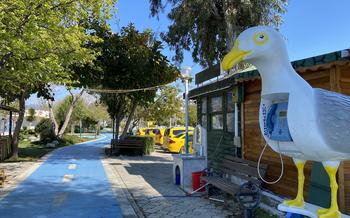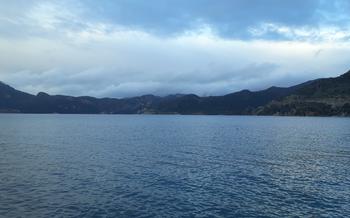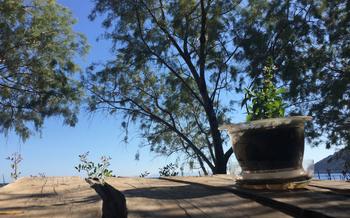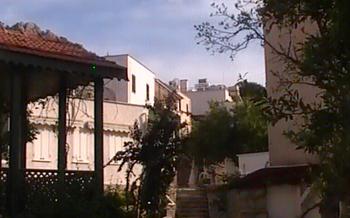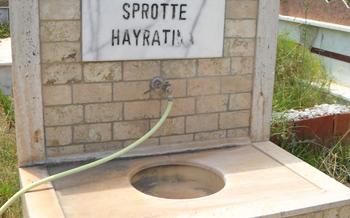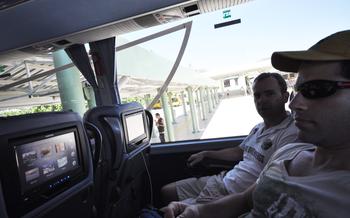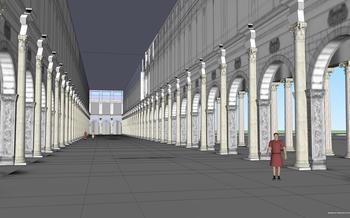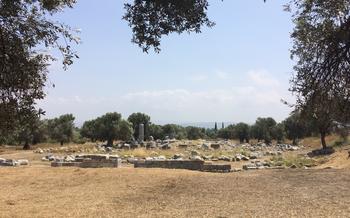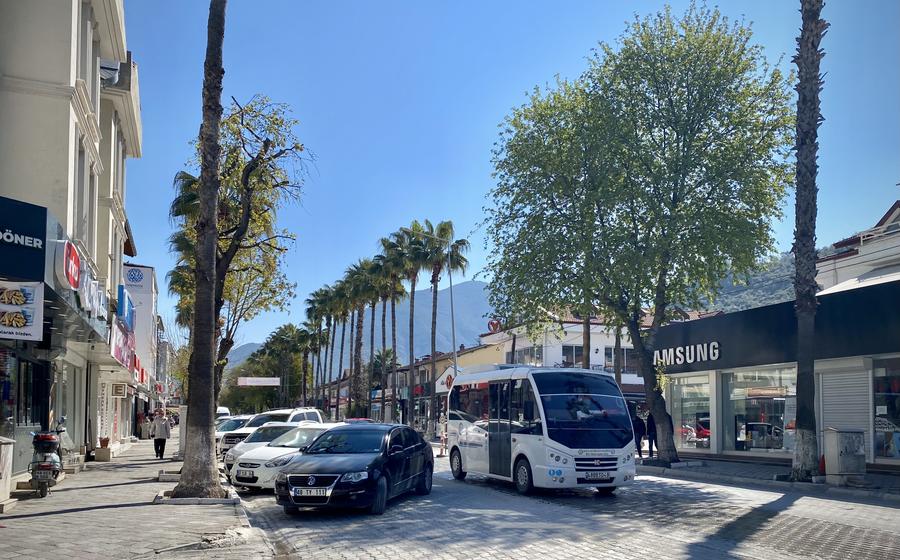
Cnidus Ancient City
- The Antiquity of Cnidus:
- The Temple of Apollo
- The Theater of Cnidus: A Stage for Ancient Drama
- Architectural Features and Seating Capacity
- Acoustics and Stage Design
- A Legacy of Performance and Cultural Significance
- The Agora of Cnidus: The Heart of Ancient Trade and Social Life
- The Necropolis of Cnidus:
- The Castle of Cnidus:
- The Museum of Cnidus: A Treasure Trove of Ancient History
- The Datça Peninsula: A Haven of Natural Beauty
- Turkish Cuisine:
- The Turkish Bath Experience
- Local Crafts and Souvenirs
- Accommodation Options
- Transportation and Getting Around
- Insider Tip: Unveiling the Hidden Gem of Cnidus
The Antiquity of Cnidus:
Cnidus, once a prominent city-state in ancient Caria, holds a significant place in the annals of history. Its strategic location on the Datça Peninsula, overlooking the Aegean Sea, made it a thriving center of trade and culture in the ancient world. Cnidus's origins date back to the 7th century BC when Dorian Greeks settled in the region. Over the centuries, it flourished under the influence of various civilizations, including the Persians, Athenians, and Romans, each leaving their mark on the city's development. Cnidus's role as a prominent city-state was further solidified by its membership in the Delian League, a powerful alliance of Greek city-states led by Athens. The city's prosperity and cultural achievements during the Hellenistic period were particularly notable, as evidenced by the impressive remains of its ancient monuments and structures.
The Temple of Apollo
The Temple of Apollo was one of the most significant religious structures in ancient Cnidus. Dedicated to the Greek god Apollo, the temple served as a central place of worship and pilgrimage for the city's inhabitants. Constructed in the 4th century BC, the temple showcased the architectural prowess and artistic talent of the Hellenistic period.
The Temple of Apollo was designed in the classical Greek style, featuring a rectangular plan with a colonnaded facade. Its elegant proportions and symmetrical composition reflected the harmonious principles of Greek architecture. The temple's exterior was adorned with intricate carvings and sculptures depicting mythological scenes and deities, showcasing the skill and artistry of ancient Greek craftsmen.
Although only ruins remain today, the Temple of Apollo still captivates visitors with its grandeur and historical significance. The remnants of the temple's columns, entablature, and pediments provide a glimpse into the architectural splendor of this ancient sanctuary. Visitors can wander among the ruins, imagining the religious ceremonies and rituals that once took place within the temple's sacred walls.
The Theater of Cnidus: A Stage for Ancient Drama
In the heart of ancient Cnidus, where culture and entertainment thrived, stood the magnificent Theater of Cnidus, a testament to the city's love for the performing arts. Built in the 4th century BC, this architectural marvel served as a gathering place for citizens to witness captivating theatrical performances, musical concerts, and public assemblies.
Architectural Features and Seating Capacity
The theater's design showcased the ingenuity of ancient Greek architects. Constructed on a natural slope, the seating area comprised of approximately 20 rows of stone benches, each capable of accommodating up to 5,000 spectators. The tiers of seats rose in a semicircular formation, ensuring an unobstructed view of the stage for every audience member.
Acoustics and Stage Design
The Theater of Cnidus was renowned for its exceptional acoustics, allowing the actors' voices to carry effortlessly throughout the auditorium. The theater's design incorporated a series of acoustic enhancements, such as strategically placed reflectors and resonators, that amplified and directed sound towards the audience.
The stage area, located at the center of the theater, was adorned with intricate marble sculptures and decorative elements. The stage provided a dynamic platform for actors to showcase their talents and engage with the audience.
A Legacy of Performance and Cultural Significance
The Theater of Cnidus played a pivotal role in the cultural life of the city. It hosted a variety of performances, including tragedies, comedies, and musical concerts. These events brought the community together, fostering a sense of shared identity and appreciation for the arts.
Today, the Theater of Cnidus stands as a reminder of the city's rich cultural heritage. Although partially restored, the theater's grandeur and historical significance continue to captivate visitors, offering a glimpse into the vibrant world of ancient Greek entertainment.
The Agora of Cnidus: The Heart of Ancient Trade and Social Life
In the bustling heart of ancient Cnidus, the agora served as the city's central marketplace and meeting place, a vibrant hub where trade, ideas, and social interactions flourished. This rectangular plaza, lined with colonnaded stoas, was the epicenter of commercial activity, where merchants from far and wide displayed their wares, from exquisite textiles to exotic spices.
The agora's layout was meticulously designed to facilitate commerce and foster social engagement. The stoas, or covered walkways, provided shelter from the sun and rain, creating a pleasant environment for shoppers and traders. Within these stoas, merchants set up their stalls, offering a diverse array of goods, from pottery and jewelry to imported luxuries.
Beyond the stoas, the open space of the agora was used for gatherings, debates, and public assemblies. Here, citizens from all walks of life came together to discuss important issues, exchange news, or simply socialize. The agora served as a melting pot of cultures, where people from different backgrounds mingled and shared ideas, contributing to the city's rich intellectual and cultural tapestry.
Today, the remains of the agora stand as a testament to the vibrant commercial and social life that once thrived in Cnidus. The foundations of shops and stalls are still visible, along with fragments of columns and decorative elements that once adorned the stoas. These remnants, though weathered by time, offer a glimpse into the bustling marketplace that was once the heart of this ancient city.
The Necropolis of Cnidus:
The necropolis of Cnidus, located on a hill overlooking the ancient city, offers a glimpse into the funerary practices and beliefs of the ancient Cnidans. The necropolis contains a variety of tombs and burial structures, including rock-cut tombs, chamber tombs, and sarcophagi. Some of the tombs are decorated with intricate carvings and inscriptions, providing valuable insights into the lives and social status of the deceased. The necropolis is a reminder of the rich cultural heritage of Cnidus and serves as a testament to the enduring legacy of its ancient inhabitants.
The Castle of Cnidus:
The Castle of Cnidus stands proudly on a small peninsula overlooking the azure waters of the Aegean Sea. Built by the Knights of St. John in the 15th century, this imposing fortress served as a strategic defensive outpost, guarding the entrance to the harbor and protecting the city from potential invaders.
The castle's massive stone walls, punctuated by sturdy towers and ramparts, exude an air of strength and resilience. Its intricate fortifications, including a moat, drawbridge, and strategically placed loopholes, showcase the ingenuity and defensive prowess of the medieval knights.
Inside the castle, visitors can explore a labyrinth of atmospheric chambers, corridors, and courtyards, each whispering tales of the past. The castle's well-preserved architecture, including vaulted ceilings, arched doorways, and ornate carvings, offers a glimpse into the artistry and craftsmanship of the era.
From the castle's ramparts, visitors are rewarded with breathtaking panoramic views that stretch across the sparkling sea, encompassing the ancient ruins, the picturesque harbor, and the lush green hills of the Datça Peninsula. The castle's strategic location, offering a commanding view of the surrounding area, made it an ideal vantage point for spotting approaching enemies and safeguarding the city from potential threats.
The Museum of Cnidus: A Treasure Trove of Ancient History
Situated in the heart of the ancient city, the Museum of Cnidus stands as a testament to the rich history and cultural heritage of this once-thriving metropolis. Within its walls, a captivating collection of artifacts, meticulously excavated from the ruins of Cnidus, paints a vivid picture of life in this ancient city-state.
A Journey Through Time
As you step through the museum's doors, you embark on a journey through time, transported back to the bustling streets and vibrant culture of ancient Cnidus. Among the museum's highlights are exquisite sculptures that once adorned the city's temples and public spaces. These masterpieces, carved from marble and limestone, showcase the exceptional craftsmanship and artistic prowess of the Cnidian people.
Whispers of the Past: Inscriptions and Epigraphs
The museum also houses a remarkable collection of inscriptions and epigraphs, providing invaluable insights into the daily lives, laws, and religious practices of the ancient Cnidians. These inscriptions, etched on stone tablets and fragments of pottery, offer a glimpse into the minds and hearts of a people who lived over two millennia ago.
Preserving Cnidus' Legacy
The Museum of Cnidus plays a crucial role in preserving and showcasing the rich history of this ancient city. Through its dedicated efforts, the museum ensures that the legacy of Cnidus remains alive, inspiring future generations to appreciate and learn from the accomplishments of this remarkable civilization.
The Datça Peninsula: A Haven of Natural Beauty
The Datça Peninsula, where Cnidus is situated, is a captivating fusion of natural wonders and historical charm. Its stunning coastline, dotted with secluded coves and pristine beaches, invites visitors to bask in the Mediterranean sun and embrace the tranquility of this unspoiled paradise. The peninsula's mountainous terrain, covered in lush forests and fragrant pine groves, offers a refreshing escape from the summer heat and provides ample opportunities for hiking, mountain biking, and nature exploration.
Nestled amidst this picturesque landscape are charming villages and towns, each with its unique character and allure. Datça, the largest town on the peninsula, captivates with its lively atmosphere, colorful harbor, and vibrant nightlife. Smaller villages, such as Knidos, Mesudiye, and Ovabükü, exude a serene charm, offering a glimpse into the traditional Turkish way of life. These quaint settlements, with their whitewashed houses adorned with colorful flowers, invite visitors to wander through their narrow cobblestone streets and soak in the authentic ambiance.
The Datça Peninsula is a haven for outdoor enthusiasts, with activities catering to every taste. From swimming and sunbathing on the pristine beaches to exploring hidden coves by kayak or sailboat, the crystal-clear waters offer endless opportunities for aquatic adventures. The peninsula's rugged coastline is a paradise for scuba diving and snorkeling, with vibrant marine life and underwater treasures waiting to be discovered. For those seeking a more active experience, the surrounding mountains offer challenging hiking trails, leading to breathtaking viewpoints and panoramic vistas.
Turkish Cuisine:
The flavors and aromas of Turkish cuisine are a testament to the country's rich history and cultural diversity. Cnidus, situated in the heart of the Aegean region, offers a culinary journey that blends traditional Turkish flavors with fresh, local ingredients. The cuisine here is characterized by its use of olive oil, herbs, spices, and succulent seafood, creating a delectable symphony of flavors that will tantalize your taste buds.
Among the must-try dishes in Cnidus is "meze," a selection of small plates or appetizers that showcase the region's culinary prowess. Indulge in "börülce," tender green beans wrapped in grape leaves and drizzled with olive oil and lemon juice. Savor the smoky and tangy flavors of "patlıcan salatası," a roasted eggplant salad seasoned with garlic, yogurt, and mint. For a taste of the sea, try "kalamar tava," crispy fried calamari served with a zesty lemon-tahini sauce.
For a main course, delight in "guvec," a traditional Turkish stew prepared in a clay pot. Succulent lamb or beef is slow-cooked with vegetables, herbs, and spices, resulting in a rich and flavorful dish that will warm your soul. Another local favorite is "pide," a boat-shaped flatbread topped with various fillings such as minced lamb, cheese, or vegetables.
No Turkish culinary experience is complete without savoring the delectable desserts. Treat yourself to "künefe," a crispy shredded filo pastry filled with sweet cheese and drizzled with a sugary syrup. Indulge in "lokma," bite-sized fried dough balls soaked in honey syrup and sprinkled with cinnamon. These sweet temptations are sure to leave you craving for more.
The Turkish Bath Experience
Indulge in the ancient tradition of the Turkish bath, a cultural cornerstone of Turkey. Immerse yourself in the soothing steam and heat of a traditional hammam, where you can relax, rejuvenate, and experience a cleansing ritual like no other. Expert masseurs will guide you through the process, starting with a full-body scrub to exfoliate and remove impurities. Next, prepare to be enveloped in a cloud of soapy foam, providing a deep cleanse and leaving your skin feeling refreshed and silky smooth. Finally, enjoy a massage to release tension and soothe your muscles, ensuring you leave feeling revitalized and invigorated. Whether you choose a private or communal bath, the Turkish bath experience is an essential part of any visit to Cnidus, offering a unique blend of relaxation, cleansing, and cultural immersion.
Local Crafts and Souvenirs
Cnidus is a treasure trove of traditional crafts and handmade products that reflect the region's rich cultural heritage. From intricate pottery and colorful textiles to unique jewelry and decorative items, there's something for every taste and budget.
Pottery:
The art of pottery has a long and storied history in Cnidus, with local artisans using traditional techniques passed down through generations. From delicate vases and plates to decorative bowls and tiles, the pottery here is characterized by its vibrant colors and intricate patterns.
Textiles:
Cnidus is also renowned for its vibrant textiles, showcasing the skillful weaving and embroidery techniques of the region. From colorful carpets and rugs to intricate cushion covers and tablecloths, these textiles add a touch of warmth and charm to any home.
Jewelry:
The local artisans of Cnidus are skilled in crafting unique and eye-catching jewelry pieces using a variety of materials, including silver, gold, and semi-precious stones. From delicate necklaces and earrings to statement rings and bracelets, these pieces make for cherished souvenirs or gifts.
Decorative Items:
Cnidus is also home to a variety of decorative items that add a touch of local flair to any space. From hand-painted ceramics and wooden carvings to traditional Turkish lamps and lanterns, these items are perfect for adding a unique touch to your home décor.
Where to Find Local Crafts:
To find these unique and authentic souvenirs, head to the local markets and shops in Cnidus. The Grand Bazaar is a particularly good place to start, offering a wide range of traditional crafts and handmade goods. You can also find local artisans selling their wares in the narrow streets and alleys of the old town.
Support Local Artisans:
By purchasing local crafts and souvenirs, you not only take home a piece of Cnidus's cultural heritage but also support the talented artisans who keep these traditions alive. So, be sure to set aside some time to explore the local markets and shops and bring back a unique reminder of your visit to this charming city.
Accommodation Options
In Cnidus, you'll find a range of accommodation options to suit different budgets and preferences. From charming guesthouses to modern hotels and cozy apartments, there's something for every traveler.
When choosing a place to stay, consider factors such as location, amenities, and proximity to attractions. If you want to be close to the city center and the harbor, look for hotels in the Old Town area. For a more relaxed and secluded experience, consider staying in one of the charming villages on the Datça Peninsula.
For budget-conscious travelers, there are several hostels and guesthouses offering affordable dorm beds and private rooms. Mid-range hotels provide comfortable accommodations with basic amenities, while luxury hotels offer upscale amenities, stunning views, and personalized service.
If you prefer a more independent stay, consider renting an apartment or villa. This option provides more space and privacy, as well as the convenience of cooking your own meals.
To ensure a memorable stay, book your accommodation in advance, especially during the peak tourist season. Research online reviews and compare prices to find the best deals.
Transportation and Getting Around
Cnidus is easily accessible by both public transportation and private transfers. The nearest airport is Milas-Bodrum Airport (BJV), located approximately 70 kilometers from the city. From the airport, you can take a direct bus or taxi to Cnidus, which takes about 1 hour and 30 minutes. Alternatively, you can rent a car at the airport and drive to Cnidus, enjoying the scenic route along the coast.
Once in Cnidus, you can explore the city on foot, as most of the attractions are within walking distance of each other. However, if you wish to venture to the surrounding areas, such as the Datça Peninsula or the nearby villages, it is recommended to rent a car or hire a taxi. Several local transportation companies offer day trips and excursions to explore the region's highlights conveniently.
To navigate the city, it is essential to be prepared for the narrow streets and limited parking. It is advisable to park your car in designated areas and explore the city by foot. Additionally, be sure to carry a map or use a navigation app to avoid getting lost, as some streets may not be well-marked.
Insider Tip: Unveiling the Hidden Gem of Cnidus
Beyond the iconic landmarks and well-trodden paths of Cnidus, lies a hidden gem waiting to be discovered. Venture off the beaten track to uncover the captivating ruins of the ancient Odeon, nestled amidst the serene landscapes of the city. This intimate theater, once a vibrant venue for musical performances and gatherings, offers a glimpse into the rich cultural heritage of Cnidus. As you step into the Odeon, let your imagination transport you back in time, envisioning the melodies that once filled the air and the lively interactions of its ancient audience. With its well-preserved acoustics and evocative atmosphere, the Odeon provides a unique and immersive experience, allowing you to connect with the spirit of this ancient city in a profound way.
For the ultimate Cnidus experience, plan your visit during the annual Cnidus Arts Festival, held every summer. This vibrant celebration showcases the city's vibrant artistic scene, with exhibitions, workshops, and performances taking place throughout the picturesque streets and historical sites. Immerse yourself in the infectious energy as local and international artists converge to share their talents, creating a kaleidoscope of colors, sounds, and emotions that will leave an unforgettable impression. The Cnidus Arts Festival is a testament to the enduring legacy of this ancient city, where art and culture continue to thrive, inviting visitors to experience the essence of Cnidus in a truly extraordinary way.
